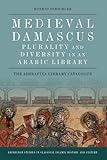Medieval Damascus : Plurality and Diversity in an Arabic Library: The Ashrafiya Library Catalogue / Konrad Hirschler.
Material type: TextSeries: Edinburgh Studies in Classical Islamic History and CulturePublisher: Edinburgh : Edinburgh University Press, [2016]Copyright date: 2016Description: 1 online resource (512 p.) : 2 B/W illustrations 54 colour illustrations 8 B/W tables 2 B/W line artContent type:
TextSeries: Edinburgh Studies in Classical Islamic History and CulturePublisher: Edinburgh : Edinburgh University Press, [2016]Copyright date: 2016Description: 1 online resource (512 p.) : 2 B/W illustrations 54 colour illustrations 8 B/W tables 2 B/W line artContent type: - 9781474408776
- 9781474408783
- 020 22//gereng
- online - DeGruyter
| Item type | Current library | Call number | URL | Status | Notes | Barcode | |
|---|---|---|---|---|---|---|---|
 eBook
eBook
|
Biblioteca "Angelicum" Pont. Univ. S.Tommaso d'Aquino Nuvola online | online - DeGruyter (Browse shelf(Opens below)) | Online access | Not for loan (Accesso limitato) | Accesso per gli utenti autorizzati / Access for authorized users | (dgr)9781474408783 |
Browsing Biblioteca "Angelicum" Pont. Univ. S.Tommaso d'Aquino shelves, Shelving location: Nuvola online Close shelf browser (Hides shelf browser)

|

|

|

|

|

|

|
||
| online - DeGruyter A History of Clan Campbell : From Origins to Flodden / | online - DeGruyter A History of Clan Campbell : From Flodden to the Restoration / | online - DeGruyter Research Methods for History / | online - DeGruyter Medieval Damascus : Plurality and Diversity in an Arabic Library: The Ashrafiya Library Catalogue / | online - DeGruyter Reassessing Legal Humanism and its Claims : Petere Fontes? / | online - DeGruyter Muslim Cosmopolitanism : Southeast Asian Islam in Comparative Perspective / | online - DeGruyter The Edinburgh Companion to Fin-de-Siècle Literature, Culture and the Arts / |
Frontmatter -- Contents -- Illustrations -- Acknowledgements -- Introduction -- 1 The Making and Unmaking of a Medieval Library -- 2 Organising the Library: The Books on the Shelves -- 3 Plurality and Diversity: The Profile of a Medieval Library -- 4 The Ashrafīya Catalogue: Translation and Title Identification -- Ashrafīya Catalogue -- 5 The Ashrafīya Catalogue: Edition -- Bibliography -- Index of Subjects -- Index of Titles -- Index of Authors -- Index of External Categories
restricted access online access with authorization star
http://purl.org/coar/access_right/c_16ec
The first documented insight into the content and structure of a large-scale medieval Arabic libraryThe written text was a pervasive feature of cultural practices in the medieval Middle East. At the heart of book circulation stood libraries that experienced a rapid expansion from the twelfth century onwards. While the existence of these libraries is well known, our knowledge of their content and structure has been very limited as hardly any medieval Arabic catalogues have been preserved. This book discusses the largest and earliest medieval library of the Middle East for which we have documentation – the Ashrafiya library in the very centre of Damascus – and edits its catalogue. The catalogue shows that even book collections attached to Sunni religious institutions could hold very diverse titles, including Mutazilite theology, Shiite prayers, medical handbooks, manuals for traders, stories from the 1001 Nights, and texts extolling wine consumption. At the same time this library catalogue decisively expands our knowledge of how books were thematically and spatially organised on the shelves of such a large medieval library.Listing over two thousand books the Ashrafiya catalogue is essential reading for anybody interested in the cultural and intellectual history of Arabic societies. Setting it into a comparative perspective with contemporaneous libraries on the British Isles opens new perspectives for the study of medieval libraries.Key FeaturesIncludes an annotated translation of the Ashrafiya catalogue and full-colour facsimile reproduction of the catalogue's unique manuscriptSeeing which books were held in the library give insights into text circulation and medieval ‘bestsellers’The publication of the catalogue provides the first documentary material for comparative research with libraries in other world regions The organisation of the catalogue contributes to the discussion on how practitioners created systems and hierarchies of scholarly fields of knowledgeRead and download the introduction for free here (pdf)"
Mode of access: Internet via World Wide Web.
In English.
Description based on online resource; title from PDF title page (publisher's Web site, viewed 20. Nov 2024)


